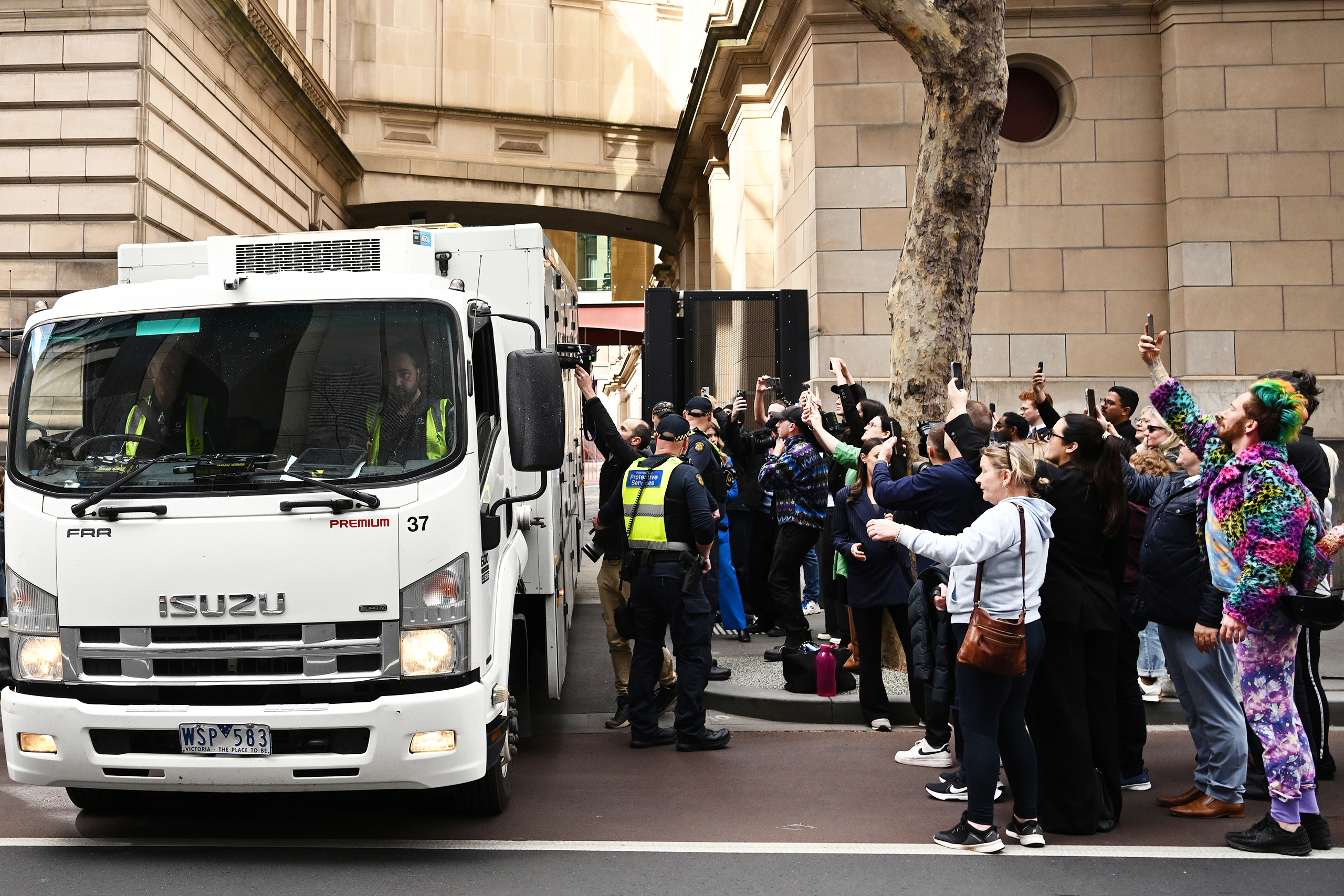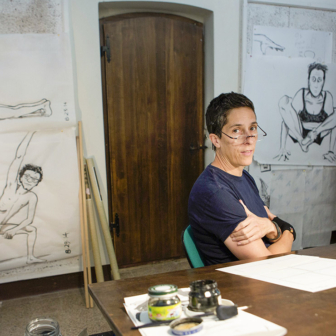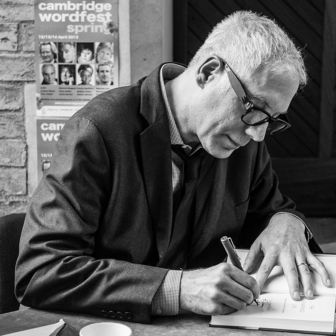“I had a strange feeling today that we’d entered a true crime tale and it was unclear who the author was,” write Helen Garner, Chloe Hooper and Sarah Krasnostein in The Mushroom Tapes, one of many books raced into print after Erin Patterson’s conviction this July for three murders, and another attempted, with a beef wellington.
The “strange feeling” line is preceded by “Chloe,” signalling two things. First, its author is Hooper, also the author of two true crime books and two novels (including one whose protagonist becomes fixated on a true crime book). And, second, the line wasn’t written at all.
Rather, the new book’s conceit is that it purports to be the transcripts of spoken conversations among the three writers during Patterson’s trial. (The reader is left to guess who wrote various uncredited paragraphs that bridge gaps in the conversation and sometimes offer pointed analyses of their own.)
Like most who followed the Patterson trial, the trio fixates on details. Hooper was riffing about how, before she became a true crime character, the accused was a very online true crime fan. “Think about all the other friendships that are now forming in Erin Patterson Facebook groups,” muses Krasnostein, who wrote two non-fiction books and many standout feature articles on criminal trials. “It’s like true crime inception.” (We are told that the authors of The Mushroom Tapes were friends before they collaborated.)
In a classic true crime twist, Patterson’s partners in true crime, her fellow participants in a Facebook group called “Keep Keli Lane Behind Bars,” became witnesses in Patterson’s own murder trial, where their role was to read out repeated posts and messages sent from the accused’s account.
The words of “ErinErinErin,” as she was known, were among the few at her recent murder trial that were written well before the fateful lunch, and therefore before everyone’s takes were infected — poisoned, you could say — by the suspicion that Patterson was a mass killer. Garner, arguably both Australia’s best novelist and its best true crime writer, was especially interested in that period. “I just want to know what happened in their marriage,” she told her companions.
The trio travelled to Morwell to watch the accused’s husband testify, but his account had left Garner unsatisfied: “something isn’t being said here.” Learning of ErinErinErin’s complaints about Simon Patterson’s “coercive control,” she revised her initial assessment of him from “admirable” to “adamant.” After Hooper recounted seeing his “media adviser” speaking to journalists about those posts, Garner added that “he wants to control the narrative and what people think of him.” Krasnostein wisely retorted: “That’s what a court case is though — two partial narratives fighting it out.” (Either meaning of “partial” works here.)
Now Garner, whose true crime classics are variously loved or hated for the way she inserts herself into the story, is part of this one. Hooper spotted Patterson nodding emphatically as she spoke with her lawyer: “He seemed to gesture over at you, as in ‘Garner’s in the court,’ and then Erin looked in your direction… I keep having a feeling that we’re characters in Erin’s story.”
It turns out that all three of the book’s authors have indirect links to the Pattersons via various educational routes: Garner and Krasnostein respectively knew co-teachers or students of Erin’s mother (a Monash university lecturer) and two members of Hooper’s family were taught by Erin’s father-in-law, who was the lunch’s third fatality. (I’m just one more degree of separation from the mass poisoning: Krasnostein was briefly my student.)
So, why aren’t we now reading Ian Wilkinson’s Consolation, say, or The Non-Believer or The Small Woman? Garner tells the others (and us): “I’m getting old… I haven’t got the wherewithal to follow a big trial by myself.” Krasnostein reveals her joy in “not being terrified to miss a detail.” Hooper’s explanation rings truest to me: that her own true crime books “opened up deeper stories in Australia” — The Arsonist also concerned a Gippsland crime, one of the Black Saturday bushfires — but “with Erin Patterson, I can’t quite read the layers under what appears to be primal violence.”
Hooper seems to envy a journalist who told her that “Erin Patterson is really normal,” poisoned her in-laws because she was angry about money and betrayal, “and thought she was smarter than everybody else and wouldn’t get caught.” This non-“baroque” explanation is “hiding like a mushroom in plain sight,” comments Krasnostein. But I’m with Garner, who previously said: “You know people always talk about motivation, which I always think is crude, like beating something mysterious with a hammer.”
My evidence law students are used to my complaining about too-easy takes on murder, so I was jarred when Garner immediately added: “you know how people in crime stories always say ‘Follow the money.’” But when the trio got to the trial’s most jarring financial detail — that Patterson had given interest-free loans to three of her in-laws — they split three ways. Garner imagines Patterson suddenly flushed after receiving an inheritance “and then, somehow, because of your husband’s belief… in duty to family, it kind of leaks out sideways.” Hooper disagrees: “it’s a way of her controlling other people.” To which Krasnostein adds: “Or maybe the family were, in her opinion, not appropriately grateful.”
The trio cycles through these depictions of sad Erin, bad Erin and mad Erin throughout The Mushroom Tapes. Hooper observes that their disagreements are “like an external version of the arguments with yourself while writing as you try decide what to put on the page.” In short, we are being sold the starter notes for three books that will never be written.
While I (and presumably Garner’s publisher) would have paid a lot more to read This House of Beef, I’ll gladly settle for The Mushroom Tapes, which allows us to imagine what the mealtime conversations many of us have been having about this case would be like if three of Australia’s best writers were guests. It’s a comfort meal with some exotic ingredients mixed in.
“Everything becomes a metaphor in a story like this,” Garner observes halfway through as they rejoin a snoozy court enduring days of mycology evidence. Their conversation plumbs analogies for fungal networks: the mobile phone system, Baptists, evidence traces, Gippsland fog, Canberrans. Hooper, either inspired by Amanita Phalloides or upset by “blokey” journos who fell outside the usual true crime demographic, dreams she has a penis.
I suspect there’s a reason why their book sags in the middle: the trio isn’t really interested in the trial evidence about whether or not Erin Patterson might have accidentally poisoned the lunch. “Do you think she’s got anybody who believes she is innocent?,” Hooper asks early on. They speculate, but it’s a rhetorical question, because no informed person really does.
The Mushroom Tapes, we are told, started life as a potential podcast. We’re never told why it “fell over,” but their recorded conversation is nothing like the various podcasts that followed the trial. Those journalists were all careful to treat Patterson’s guilt or innocence as an open question, just as the court did, carefully engaging with the trial’s various mysteries about trips to the forest or the tip or the loo. The twist is that they were all pretending to be puzzled.
Page 22 captures the moment, just after Patterson’s husband’s testimony, when Garner was spoiled:
Helen: What about Simon’s self-command. He’s really got a grip on himself, hasn’t he?…
Sarah: But there’s strong emotion beneath the surface.
Chloe: His tone is even more astonishing when you think, this man has been in a coma.
Helen: He was in a coma! What? How did you hear that?
Chloe: I read about it in the Daily Mail. He wasn’t expected to live. In 2022, a year before the lunch, he was hospitalised a few times and his family were called in more than once to say goodbye.
Hooper then tells Garner that the hospitalisations were the reason Patterson originally faced multiple attempted murder charges, which were dropped on the eve of the trial. The jury had been told to put the charges out of their minds and Garner had assumed (as everyone hoped the jury did) that those “must have just been rumours about her that the judge was hosing down.”
They weren’t rumours. Nor were they, as I initially figured, events that were only regarded as suspicious in hindsight. Rather, like ErinErinErin’s posts, concerns that the accused was a serial poisoner were voiced well before the fatal lunch: first to an initially sceptical Simon, and then by him to several, including his father and various doctors.
In short, the mystery in the Patterson case wasn’t “Could someone have somehow innocently poisoned most of her in-laws?” but rather “Could a suspected repeat poisoner have somehow innocently poisoned most of her in-laws?” Krasnostein, the trio’s legal expert, calls this “the ghost case”: “The legal story is always haunted by a whole chunk of reality that’s excluded from the room by the rules of evidence. But here, the story of Simon’s poisoning is running under everything that’s being said.”
At this point, I’d typically put my evidence law teacher hat on to explain why the beef wellington trial wasn’t also the penne bolognese, chicken korma, beef stew and curry wrap trial, but I’m not sure I can. In 1995, Australia’s High Court decided the usual rules keeping separate events out of criminal trials don’t apply if those events — in that case, evidence that a man who was the last to see a missing ten-year-old kidnapped and abused a thirteen-year-old the following year — remove any real doubts about the accused’s guilt. But Victoria’s judges now follow more abstract statutory rules, which they and everyone else routinely disagree about.
In Patterson’s case, two such judges held that the evidence about Patterson’s husband was too weak because it requires “circular reasoning.” Two others totally disagreed — there was no circularity and the evidence provided a “solid foundation” — but, applying a (now) uniquely stringent Victorian rule, held “after anxious consideration” that the evidence would create such “a highly suspicious, prejudicial atmosphere” that it would be “nigh on irresistible” for a jury of non-lawyers to find her a poisoner, whatever the other evidence. In short, the evidence was too strong for ordinary jurors to deal with.
Whatever its merits, this ruling meant everyone inside Patterson’s courtroom had to spend eight weeks acting out a fiction. The judges. The lawyers. The lead police investigator who pretended he only suspected Patterson after a few weeks and a computer analysis. The doctors who recounted their earnest interactions with Patterson and her victims.
(In a rare misstep, the unidentified narrator of The Mushroom Tapes suggests Patterson’s initial failure to reveal her foraging denied her doctors a chance to administer a “liver-protecting drug much sooner” to her victims. But it seems clear her claim to have bought the mushrooms was never believed, likely because the doctors had already heard of her husband’s suspicions.)
Saddest of all, Simon Patterson himself had to gloss over the real reason he skipped the fatal lunch, as well as the devastating fact that his father knew why. Listening to his testimony (before she was spoiled), Garner remarked on “those long silences, and then you hear him taking a breath.”
The complicity in lies extended beyond the courtroom to the hundreds of journalists and podcasters who covered the trial. Each one had to pretend that either of the contesting narratives they pored over resembled reality. Except, that is, the abandoned podcast of Garner, Hooper and Krasnostein that became The Mushroom Tapes.
The trio’s conversation covers what no contemporary accounts could: what Krasnostein termed the “shadow case” that was “edited out according to the rules of evidence.” I’d put it differently: the trial was in the shadow. The Mushroom Tapes tells the real story of a crime in which the mushrooms were totally beside the point.
Let me be clear: everyone’s lies were in a good cause. Without them, Erin Patterson could not be tried at all in the one way the law allowed. As Krasnostein notes of the lawyers who brilliantly handled this fraught situation, “every extra day increases the risk of something fucking up with the jury. They were really up against it.” If they had failed, we wouldn’t be able to read conversations like Garner, Hooper and Krasnostein’s. (Garner ruled out covering a retrial.)
The trio, like everyone else, muses on why so many want to talk about this particular case. The poison? The female accused? The domestic setting? How women seem especially interested in true crime? Garner concludes: “We’re bearing witness to a rent in the social fabric and how the law is going to deal with it.”
We almost didn’t. Victoria’s courts ordered two separate trials, one covering the lunch and the other concerning the earlier meals. Had that plan been carried out, the lunch trial would surely have been a repeat of the George Pell’s prosecution over alleged events in St Mary’s Cathedral, with all contemporaneous local coverage banned, up to and including the jury’s guilty verdict. This time, prosecutors ruled out the second trial in time to let the media cover the first as it happened.
Perhaps the prosecutors weren’t sure they could prove beyond reasonable doubt that Patterson tried to kill her husband without the benefit of hindsight from the lunch. Or maybe they were just confident, as the Victorian judges were, that when it came to her other in-laws their case was “extremely strong” even without the evidence about Simon Patterson’s illnesses. Or perhaps they didn’t relish a repeat of the blanket secrecy that contributed to the failure of the Pell prosecution to heal a societal wound.
It’s also possible the judges ruled as they did because they wanted to reduce the risk of (again) having a guilty verdict overturned down the track. (Patterson has just filed an appeal, raising seven relatively minor complaints.)
Is everyone a member of the “Keep Erin Patterson Behind Bars” chat group? If so, I have some bad news for the crowd.
All of the well-meant legal machinations have placed Erin Patterson’s conviction on a single fragile foundation. According to a recent High Court rule, her conviction will instantly fall over if it ever emerges that even one juror knew more than Justice Beale told them about the alleged attempts to murder Simon Patterson. To me, the belief that none of her jurors were privy to what seems to have been an open secret surrounding the most-discussed trial in Victorian history is one fiction too many.
“It’s a relief,” Garner tells her friends, “to be with someone who is familiar with the story and the people in it. You can just mention something and they know.” That’s how I felt reading The Mushroom Tapes, because “the story” is now the whole one. It’s how everyone can now feel.
So, yes, you absolutely should accept your surprise invitation to conversation over lunch with Garner, Hooper and Krasnostein, and the chance to turn familiarity into something deeper. There’ll be awkward moments, of course, but you know you’ll receive some fine morsels, the odd intimate reveal and maybe a little more. And you never know whether you’ll get to spend time with this crowd again. •
The Mushroom Tapes: Conversations on a Triple Murder Trial
By Helen Garner, Chloe Hooper and Sarah Krasnostein | Text | $29.99 | 256 pages




